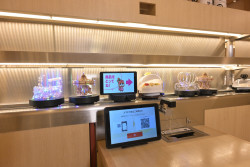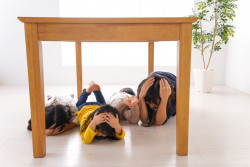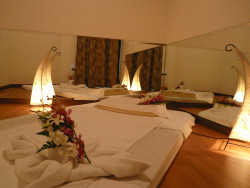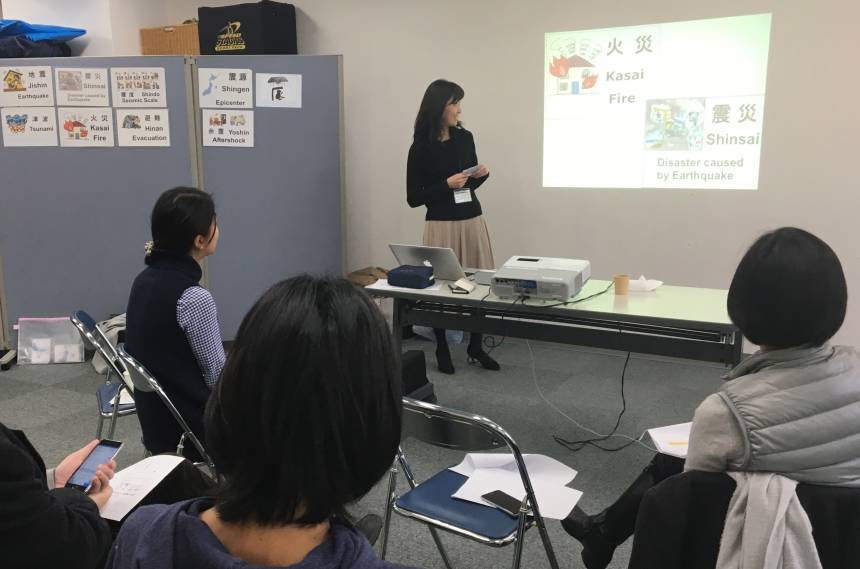
March 5, 2017
Earthquake Smarts
Improving your chances of surviving the "big one" with WaNavi Japan
We’re an international group of adults and a few kids rushing around a conference room at Minato City’s Gender Equality Center Libra. “Jishin ga kimashita. Tsukue no shita ni kakurete kudasai.” (Earthquake. Please take cover under a desk.) Under the desks we go. “Tsunami ga kimasu. Takai tokoro ni nigete kudasai.” (Tsunami. Please escape to high ground.) We all speed over to the picture of stairs stuck on the wall.
We’re practicing disaster vocabulary midway through an English-language workshop on earthquake preparedness. After some repetition and a lively game of karuta (a Japanese card game) to reinforce the vocab, even the non-Japanese speakers among us are able to pick out the important words and react accordingly, something that could save their lives should a big temblor hit Tokyo.
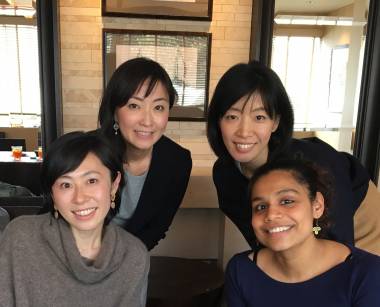
Vocabulary makes up just a small part of the 2.5-hour program run by WaNavi Japan and, for this particular workshop, hosted by Minato City’s Gender Equality Center. Beginning with earthquake literacy (did you know Japan is home to 10 percent of all earthquakes, and 20 percent of all quakes of magnitude 6 and higher?), the workshop runs through everything from how to prepare for an earthquake, how to react, and how to keep abreast of the news. It also goes through tsunami know-how, how to contact loved ones, and neighborhood hazards. Peppered throughout are disaster facts, videos from the 1995 Kobe earthquake, and NHK disaster broadcasts to illustrate important points.
The workshop is one of a number of programs run by WaNavi, a non-profit organization created to provide support to international residents of Japan. The brainchild of Motoko Kimura, WaNavi was born out of the turmoil that followed the Tohoku earthquake and tsunami of March 2011. Through conversations with friends from the international community, Kimura discovered how overwhelmed and underprepared many were.
“Many of them claimed that they had never been through any kind of disaster preparedness education,” Kimura shares in the workshop’s introduction. Many of her friends who are mothers lamented that “they wanted to protect their children, but they didn’t know how.” Hearing their struggles, Kimura and friends decided to organize a workshop to empower the foreign community by teaching them earthquake literacy.
Since their first workshop in May 2011, Kimura’s project has taken off, with workshops held at schools, embassies, centers like Libra, and at smaller venues for private groups. As of January 2017, 1,962 people had participated, and the feedback is glowing. “It was really informative, and I really appreciated that they made it child-friendly with a little play corner set up… I’d definitely recommend the workshop to others,” shares Jacqueline Kaga, a past participant.

The workshop held at the Minato City Gender Equality Center Libra benefited from the support of Libra’s Business Promotion Unit. Unit leader Kohei Nomura and his team provided a variety of multilingual materials, including an English version of the extremely thorough—and vibrantly yellow—Disaster Preparedness Tokyo manual (Tokyo Bousai; available online in English at www.metro.tokyo.jp/ENGLISH/GUIDE/BOSAI/index.htm). Though Libra had hosted earthquake preparedness workshops in the past for Japanese residents of Minato City, the joint venture with WaNavi was the first one aimed at foreign nationals, who, Nomura notes, make up 10 percent of Minato’s population.
“We thought that we have already done enough for [Japanese residents] to call their attention to earthquakes,” Nomura explained in a follow-up e-mail on how the workshop came about. “We have to [spread awareness] to the international community.”
While whether Libra will host another earthquake preparedness workshop with WaNavi is still unknown, WaNavi posts its upcoming workshops and cultural events on its website and Facebook page. The WaNavi website also includes a link to printable resources, like help cards, emergency plans, and to-do lists. These printouts are also provided to workshop participants.
For a fee, it’s also possible to organize workshops, either something small with friends (minimum five participants), or something larger for a school or business. For anyone planning to be in Japan for the medium to long-term, it’s a worthwhile investment of time and money—one that might just save your life.
*For information on workshops, please visit WaNavi Japan’s website at www.wanavi.org, or visit their Facebook page at www.facebook.com/wanavi.japan1.
Resources
While no one likes to think about it, earthquakes are simply a part of life in Japan. One of the best ways to try to ensure your safety and that of your loved ones is to be prepared. The following list of resources – websites, apps, and message boards—will help you know what to have on hand, how to leave messages for loved ones near and far, and find the help you need.
Check out our article on WaNavi earthquake readiness workshops and our Earthquake Ready Kit List, too.
Have suggestions for other places and more useful information? Please contact us and let us know!
GENERAL RESOURCES
WaNavi Japan www.wanavi.org
Tokyo Metropolitan Government Disaster Prevention Website
www.bousai.metro.tokyo.jp/foreign/english/index.html
Tokyo Metropolitan Government, Tokyo Bousai (English version)
www.metro.tokyo.jp/ENGLISH/GUIDE/BOSAI/index.htm
Tokyo Metropolitan Disaster Prevention Map
map.bousai.metro.tokyo.jp/bousai/en/pc
DISASTER INFORMATION
Japan Meteorological Agency
www.jma.go.jp/jma/indexe.html
NHK World www3.nhk.or.jp/nhkworld
NHK World Radio Japan
www3.nhk.or.jp/nhkworld/en/radio
(AM 693)
InterFM897 www.interfm.co.jp (FM 87.9)
American Forces Network Pacific
www.afnpacific.net/AFN-360 (AM 810)
SAFETY CHECK-INS
Facebook Safety Check
www.facebook.com/help/695378390556779
Disaster Emergency Message Dial (171) www.ntt-east.co.jp/en/saigai/voice171 (English-language instructions for how to use emergency voicemail service)
CELL PHONE PROVIDER MESSAGE BOARDS
NTT Docomo dengon.docomo.ne.jp/top.cgi
Softbank dengon.ne.jp/J
AU by KDDI dengon.ezeweb.ne.jp
Y! Mobile (Willcom) dengon.willcom-inc.com
Y! Mobile (EMOBILE) dengon.emnet.ne.jp
APPS
Yurekuru – iOS and Android (early earthquake warning system, safety confirmation, etc. Extra functions available for monthly fee)
Safety Tips – iOS and Android (earthquake and tsunami warnings, tips, communication cards, etc.
More information:
www.mlit.go.jp/common/001058867.pdf)
SIMULATIONS
The Tokyo Rinkai Disaster Prevention Park www.ktr.mlit.go.jp/showa/tokyorinkai/english/72h/1f.htm
Ikebukuro Life Safety Learning Center (Ikebukuro Bosaikan)
www.tfd.metro.tokyo.jp/hp-ikbskan
(This website is mostly Japanese, and it states that tours are Japanese language-only. Non-Japanese speakers are welcome to participate with someone who can interpret for them.)
Survival Tips
Plan ahead – Arrange a central meeting place for family members, and practice getting there from your various locations. Discuss communication possibilities, like the Disaster Emergency Message Dial (171) system (www.ntt-east.co.jp/en/saigai/voice171/).
Check WaNavi’s website for helpful checklists (www.wanavi.org).
Check your pack – What you need in your emergency pack will change with the seasons, so keep it up-to-date. Individualize packs bought as a set with diapers, feminine hygiene items, your personal information (and embassy contact information), and anything else that you need. Make a note of any food or drinks with expiry dates.
Know your neighborhood – What hazards line your streets (e.g., cinder-block walls)? Are there potable water sources nearby? Do you live in a tsunami danger area or somewhere prone to landslides? Any fire hazards around? Where is your closest evacuation area? Are there any gas stations or convenience stores nearby that provide emergency provisions? Make a map and note what could help or hinder your survival.
Get to know your neighbors – Having a strong neighborhood network can provide you with comfort and security, not to mention information.
Sleep safe – Make sure nothing heavy sits above your bed, and keep a flashlight, a whistle, and a pair of shoes within arm’s reach.
Buckle up – Anything big that could tip over needs to be securely fastened, and exits need to be kept clear of anything that could block them.
Practice – Having a plan is only half the battle. Make sure you can put it into use, too.
Visit the community section of our website at metropolisjapan.com/living/community to pack your emergency evacuation backpack.


